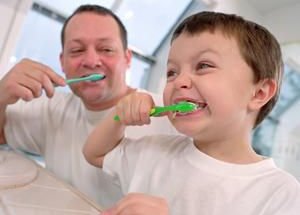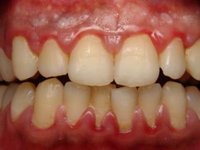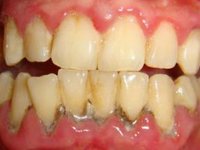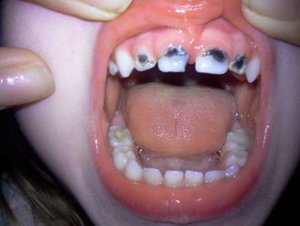Caries is the most common dental problem. To avoid its appearance, it is necessary to observe oral hygiene and strengthen tooth enamel using special pastes and rinses, as well as undergoing a remineralization procedure at the dentist.
How to prevent caries in children and adults?

Stopping the development of caries
It is desirable to stop the development of caries at the earliest possible stage: in this case, the disease will be much easier to treat.
At the initial stage, caries looks like a small spot. At this stage of development, it can be covered with a special gel that can restore damaged enamel. If you consult a doctor on time, then you may be able to do without the preparation procedure, which, of course, is completely painless.
If you start the development of caries, you will have to resort to drilling, and if the pulp is affected, then this can add additional pain.
In addition, ignoring caries is fraught with:
- the destruction of the affected tooth and, as a result, the costly installation of the implant;
- indigestion, since the affected teeth cannot fully cope with the function of chewing;
- aesthetic inconvenience.
Prevention of caries: local methods
These caries prevention methods include:
- Remineralization is a procedure during which tooth enamel is saturated with fluorine and calcium, which has a positive effect on its strength. In addition, fluoroprophylaxis increases the resistance of enamel to the action of microorganisms that provoke the development of caries.
When acidity falls below pH5, the concentration of calcium and a number of other elements in tooth enamel begins to rapidly decrease. It is at this moment that the greatest activity of cariogenic organisms is observed. After coating the surface of the tooth with fluoride varnish, fluoride begins to penetrate into the enamel, which, together with calcium, does not allow it to dissolve even in conditions of high acidity.
Remineralization can be:
- Homemade , which consists in the most ordinary thorough brushing of teeth with pastes, which contain fluoride. There are pastes with a more effective aminofluoride (they have a higher price and a faster rate of penetration of fluoride into the enamel), as well as with sodium monofluorophosphate (they are a budget option). For a more professional fluoride prevention course, in addition to toothpastes and rinses, you will need remineralizing gels, which should be used every 3-4 months, which does not cancel brushing your teeth. If you follow these rules throughout your life, chances are good that you will never have to treat cavities.
- Professional , for which you can not do without visiting a doctor. Its main advantage is better efficiency due to the use of drugs that are characterized by an increased concentration of active ingredients. During the procedure, the teeth are covered with a transparent fluorine-containing varnish, which actively penetrates into the enamel for several hours. Gradually the film dissolves.
WHO recommends fluoride prevention in two ways: using fluoride pastes at home and periodically resorting to the use of professional preparations that modern dentistry can offer.
- Proper oral hygiene , which is both a simple and very important step in the prevention of caries , prevents the appearance of carious areas.
A considerable part of people believe that they have everything in order with oral hygiene. However, if this were true, the disease would not be so common.


How to prevent caries
- Regular brushing of teeth (preferably after each meal). Moreover, you should brush your teeth not in an hour or two, but within 5 minutes after eating. It has been proven that food debris and pathogens have the maximum damage to the teeth in the first 40 minutes. Is it necessary to brush your teeth after every meal, that is, even after a light snack or tea with candy? Yes, it is necessary, and this must be clearly understood for yourself. Therefore, do not abuse snacks during the day.
- Dental floss is not an additional tool for cleaning the oral cavity, but the same main tool as a toothbrush. Floss must be used in the same way after each meal. It can be difficult for a person who has never used a thread before to understand how to wield it – a dentist can help with this . The task of flossing is to remove food debris between the teeth (caries rarely develops not only in the cavity of the tooth, but also between two adjacent teeth).
- What to do if brushing your teeth is problematic (for example, in a cafe or in nature)? You should always have dental floss or, in extreme cases, chewing gum with you. A package with a thread does not take up much space, and you can use it by going to the toilet (if we are talking about a room) or stepping aside. Many people are embarrassed to behave this way, as a result, subsequently they will not always have a simple and cheap caries treatment . Embarrassment is inappropriate here: there is nothing shameful in getting up and going to the restroom for a couple of minutes. It is much better to breathe freshness later, and not to “please” those around you with the aromas of a recently eaten dinner.
- Food debris often accumulates under dentures and braces . People who have crowns in their mouths can be advised to use an irrigator – a device that delivers a jet of water through a special nozzle, saturated with air bubbles and washing away food debris. The device is especially effective for gingivitis and periodontitis, when pockets form, where a large number of microbes accumulate. Periodontal pockets are very difficult to clean with a brush or floss, but the irrigator is able to cope with this task perfectly. The device is also recommended for pregnant women, often suffering from gingivitis.
In addition to brushing and flossing, the following can help prevent cavities:
- strengthening immunity. A weakened body is not able to fully resist the effects of bacteria. To minimize the risk of developing caries, subject to good hygiene, you need to take care of immunity through the use of vitamins, hardening;
- properly formulated diet. First of all, you need to reduce the consumption of simple carbohydrates, as well as increase the amount of foods containing fluorine and calcium in the menu. We must not forget about the regular use of hard fruits and vegetables that clean the teeth from plaque.
Caries: general methods of prevention
- The main reason for the development of caries is carbohydrates consumed during meals (simple carbohydrates, i.e. sugars, are especially harmful). As a rule, a person consumes these elements between main meals (for example, drinking tea with sugar or confectionery). If you refuse snacks, you will reduce the risk of cavities.
- The use of vitamins that prevent the development of caries. In Russia, this method is not very common, although the anti-caries effect of vitamins B6 and B1 has long been proven. However, no pill, even if taken on a regular basis, can prevent cavities if oral hygiene suffers.
- Fluorination. This method of preventing caries helps to strengthen the strength of the enamel, increase its resistance to acid, and also get rid of the pain reaction to eating too hot or cold food. In simple fluoridation, a fluoride gel is applied to the tooth. Deep fluoridation involves sealing the enamel. This is a longer process, for which the teeth are first dried, then deep fluoride is applied to them, followed by re-drying and the use of calcium copper hydroxide.
- Infiltration. With this method of preventing dental caries, the stain is lubricated with an etching composition, then a preparation is applied to the cleaned surface of the tooth that seals the pores. Infiltration allows you to stop the development of caries and the increase in the size of the carious spot, since the acid secreted by bacteria is not able to penetrate into the enamel. The method is absolutely painless, therefore it is recommended, including for children. The only condition for the successful completion of the procedure is sitting still for 20 minutes, so infiltration may not be suitable for restless babies.
- Ozone therapy.
- laser therapy.
If a hole has already appeared in the tooth, then the above prevention options will not help: you will have to resort to surgical intervention.

Dental caries in children
In children, identifying caries is quite simple: first, white or brown spots appear on the teeth, then the teeth begin to react to hot or cold food, bad breath may appear. All these symptoms indicate the rapid development of the disease. If you do not take action in time, the infection can spread to several teeth at once.
Causes of caries in children:
- The main cause of childhood caries is poor oral hygiene . The task of parents is to choose the right toothbrush for the child and teach him how to brush his teeth. Many young children are afraid of this harmless procedure, so it can be recommended to try to present brushing teeth as a game. It is necessary to accustom a child to self-cleaning starting from the age of 3 (before this moment, parents should clean the gums and teeth of the baby).
- The infection can be passed from an adult to a child . As a rule, this happens if you eat with a child with one spoon or kiss him on the lips, which is often abused by adults who are unable to cope with an overabundance of feelings.
- Genetic features associated with maternal lifestyle during pregnancy . Teeth are formed in the first trimester, so if a woman smokes or drinks alcohol, it can affect the development of a baby’s teeth.
- Early tooth decay that occurs in children before the age of 2 years may be caused by poor mineralization of milk teeth .
- Various chronic diseases can also cause the appearance of carious cavities.
- Infants often develop bottle caries when the child consumes food before bed. After eating, the remnants of food remain on the teeth, and parents, instead of brushing the child’s teeth, put him to bed.

findings
There is a clear algorithm, following which with a high degree of probability will never encounter the problem of caries.
- Regular removal of plaque and tartar is the key to healthy teeth . High-quality oral hygiene is the best cure for any diseases associated with teeth and gums.
- Proper diet . It is necessary to draw up a daily menu in such a way that it contains as little flour and sweets as possible (food consisting mainly of easily digestible carbohydrates). It is worth giving up sugary drinks (extremely more sugar is found in soda). By avoiding sugary snacks, you minimize the risk of tooth decay.
- Activities that increase enamel resistance to acids produced by pathogens should be carried out several times a year.
